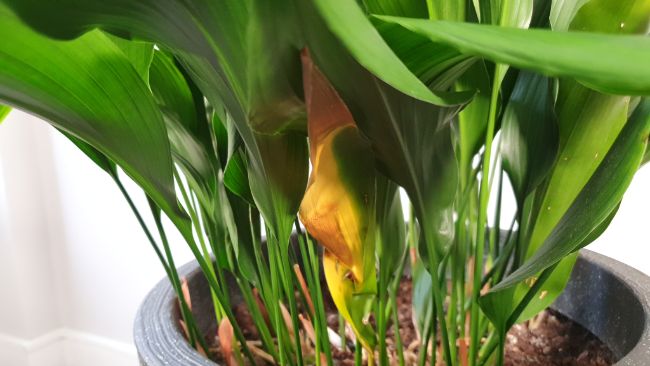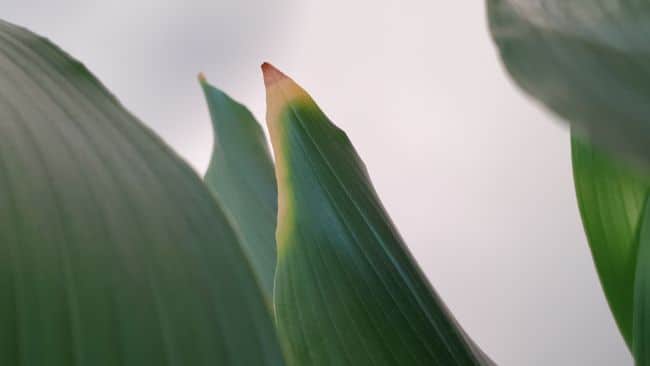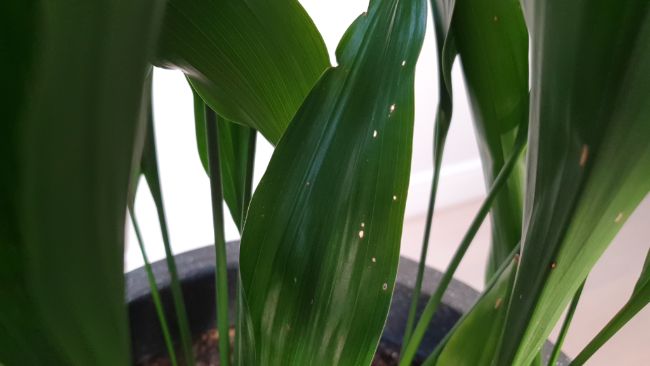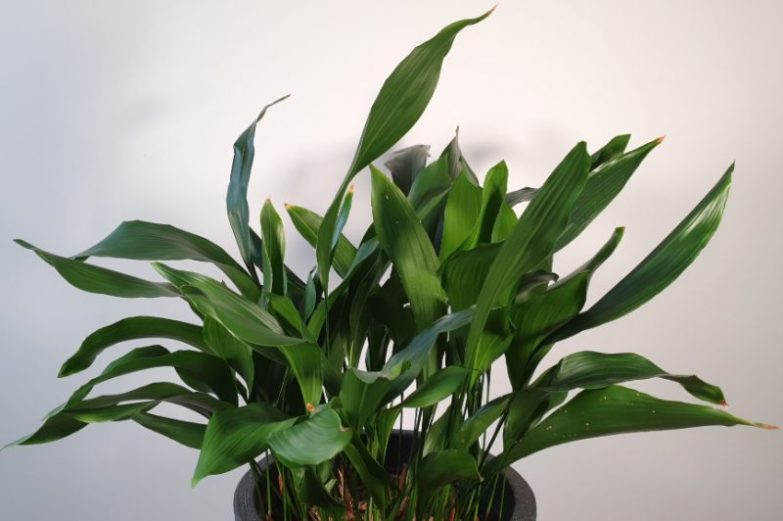Aspidistra gets its common name, the Cast Iron Plant due to its reputation for tolerating a lot of neglect and being as tough as iron. Whilst this is true, there are still a few common problems. If your Aspidistra has brown leaves, this article will help you work out what is going on and get your plant back to perfect health.
Cast Iron Plants (Aspidistra) most commonly get brown leaves due to either overwatering or underwatering. Water your plant once the top half of the soil feels dry to prevent this. Excess light, overfertilizing, temperature stress, pests, disease, acclimation, or old age can also cause brown leaves.
Read on and I’ll explain how to work out what is causing your Cast Iron Plant to get brown leaves and show you the steps to fix your plant.
9 Reasons Why Your Aspidistra Has Brown Leaves
Let’s start with a quick rundown of the main causes of brown leaves on Cast Iron plants, before going into more detail to help you identify what the problem is with your plant. I’ve listed the most likely reasons at the top, and the less likely causes further down.
Underwatering – Cast Iron Plants prefer the top half of their soil drying out before being watered again. However, if the soil dries out too much, your plant will get brown leaf tips, and some of the lower, older leaves may turn brown and die.
Overwatering – If your Aspidistra is left in soggy soil for long, it will develop root rot. The lower leaves may start to turn yellow first, but then they will develop brown tips, followed by some of the leaves turning brown and dying. The plant may also wilt, despite the soil being wet.
Excess Light – Cast Iron Plants prefer bright, indirect light, but can tolerate fairly low light levels. Direct sunlight will scorch the leaves, causing brown patches, brown tips, or even entirely brown leaves.
Old Foliage – From time to time, a single leaf will slowly turn completely brown and die. This is a normal process where the plant focuses its attention on younger foliage at the expense of older leaves. This is normal and should not cause concern.
Acclimation – When you bring your Aspidistra home or change its location, it must adapt to the change in conditions. Sometimes, this can involve some leaves turning brown, particularly if moving to a colder or darker location. You may also see brown tips developing if the new conditions are unsuitable.
Overfertilizing – Excess fertilizer added to the soil can cause brown leaf edges and tips due to the toxicity of excess fertilizer salts in the leaves. Fertilizer buildup in the soil can also damage the roots, preventing the absorption of water, and causing signs of dehydration, including brown leaves.
Drafts/Temperature Stress – Aspidistra elatior can tolerate temperatures of 45-85°F (7-29°C). Outside these temperatures, particularly at the low end, the plant will experience significant stress, resulting in browning foliage and a plant that languishes.
Diseases – Whilst generally disease-resistant, in combination with overwatering, you may see multiple brown spots or large brown patches on the leaves of your Cast Iron Plant, indicating infection.
Pests – Spider mites, mealybugs, scale and thrips can do considerable damage to a Cast Iron Plant, causing irregular brown or yellow leaf spots where they have fed. Inspect the plant closely for any signs of pests.

How To Know Why Your Cast Iron Plant Has Brown Leaves
Thankfully, you can normally work out why your Cast Iron Plant has brown leaves by looking at the other symptoms your plant is showing, as well as looking at the recent care conditions you have been providing. It’s essential to identify the problem first, before trying to fix your plant.
Overwatering
This is the most common cause of brown leaves on a Cast Iron plant and is likely to lead to a dying plant unless identified quickly.
Signs that overwatering is causing brown leaves on your Cast Iron Plant;
- Generally yellowing leaves, particularly affecting the lower leaves.
- Soil that feels soggy, even many days after watering.
- Brown leaf tips despite regular watering.
- An offensive smell coming from the soil – this is a sign of root rot.
- The soil drains very slowly after you water your plant, often sitting on the surface of the soil for several minutes.
- Your plant is in a large pot relative to the size of the plant – This leads to the soil staying wet for a long time after watering.
- Your plant is in low light, which results in slower growth and reduced water requirements, making overwatering much more likely.
- The plant pot has few or no drainage holes.
- You sometimes forget to empty the drip tray after watering.
Look for a combination of these issues to indicate that overwatering is the cause of brown leaves on your Aspidistra.
If symptoms are very mild, and can simply cut back on watering, and make a few adjustments to prevent a recurrence. However, if you think root rot has set in, you are best to repot the plant, as this may be the only way to save it. Follow the steps in this article to try to save your plant from root rot.
Underwatering
Cast Iron Plants are fairly drought tolerant, and are best left until the top half of the top half of the soil feels dry before watering. However, it’s very easy to leave things too long, and Cast Iron Plants wont give you too many clues that they are being underwatered.
Eventually, they will start developing brown leaf tips, and a few lower, older leaves may also turn brown and die. The reason this happens is that the leaf tips are the furthest point from the roots, and the most likely to suffer when water is scarse.
It’s not usually too hard to identify when brown tips have been caused by underwatering, as the soil will be totally dry, and you may realize that you have forgotten to water your Cast Iron Plant for a long time.
You may also see some leaf curling or rippling, as they contract from lack of water. Any brown leaves will feel hard and crispy. The solution here is simple. Just start watering your plant, and monitor how dry the soil is every few days, so you can water again once the top half feels dry.
If you’d like more tips on how to tell when your houseplants need to be watered, you can read this article.

Overfertilizing
Most people I know want their plants to grow big and beautiful, and fertilizing is an important aspect of this. However, although nutrients in small quantities are really helpful for your plant, larger quantities can be toxic.
If you fertilize your plant too frequently or use a preparation that is too strong, it will cause toxic build-up in the leaves, leading to direct leaf damage and browning. It will also cause root damage, impairing the ability of the roots to function normally.
The build-up of nutrients over time can also lead to a situation where water cannot enter the roots as the salt concentration in the soil is higher than that in the plant, preventing water absorption.
I fertilize my Cast Iron Plant every 4 weeks during the spring and summer and hold off fertilizing during the rest of the year. I use this balanced (20-20-20) fertilizer and make it up at half the strength recommended for outdoor plants. Read my guide to fertilizing indoor plants for more info.
The following may indicate that excess fertilizer is the cause of your Aspidistra getting brown leaves;
- Feeding your Cast Iron Plant more than once per month, or using a concentration that is too strong.
- Signs of white/yellow fertilizer salt build-up on the top of the soil.
- Leaf browning at the tips, or in brown patches along the sides of the leaves.
If you think overfertilizing may be the cause of the brown leaves, stop fertilizing and do one of the following.
- Flush the soil with copious quantities of water. This will help to flush excess fertilizer salts out of the soil, reducing root toxicity.
- Repot your plant in fresh potting soil.
In both cases, hold off fertilizing your plant for at least 6 months, and then resume with a more conservative dosage and frequency.
Excess Light
Aspidistra elatior likes to grow in bright, indirect light. Direct sunlight can scorch the leaves, turning them brown. Observe your plant at various points in the day to see if it is getting any direct sunlight.
Move your plant as needed so that it is kept out of most direct sunlight. Bear in mind that your plant will adapt to the conditions it is growing in. A plant that has been used to getting brighter light may be able to tolerate 1-2 hours of direct sunlight in the morning or late afternoon.
However, a plant that has been growing in more dim conditions and is moved into the same light level as the other plant, may start getting brown leaves as it struggles to adapt.
Drafts/Temperature Stress
Although much more tolerant than many houseplants, low temperatures and hot or cold drafts can cause brown leaves on Aspidistra Plants. Temperatures much below 45°F (7°C) can cause direct damage to the foliage, resulting in brown tips or entire leaves turning brown.
This is more likely to be an issue if you keep your plant outside in the summer and forget to bring it indoors before the colder nights arrive.
Alternatively, hot or cold drafts can cause brown leaf tips but are unlikely to kill your plant. You should ideally situate your plant somewhere away from any drafts and provide consistent temperatures.
Diseases
Whilst generally disease resistant, an overwatered or otherwise weakened Cast Iron Plant can suffer from disease. You may see scattered brown spots or larger brown/black patches on the leaves that do not appear to be caused by pests.
Assume these are caused by disease until proven otherwise. The best thing to do is to carefully prune off all affected leaves using sterile pruning shears and dispose of all affected foliage carefully.
Examine your plant for other signs of stress that might have caused the problem and make any changes necessary.
Pests
Scale, mealybugs, and spider mites are the most likely bugs you will see on your Cast Iron Plant. They feed directly on the leaves, causing leaf damage at the point where they have fed. This results in small, irregular yellow or brown spots on the leaves, with entire leaves turning brown if they are damaged sufficiently.
The solution for pests is to remain ever vigilant. Make sure to carefully check the leaves and stems of your Cast Iron Plant for any signs of pests on a regular basis. Treating infestations at an early stage is crucial to prevent major damage to your plant.
You can read my guide to identifying, treating and preventing houseplant pests to learn more.

Old Foliage
From time to time, you may see one or two leaves on your Cast Iron Plant turning brown. If the plant looks otherwise healthy, then this is most likely related to the normal loss of old leaves.
It is more likely to occur in fall and winter when growth slows for the year, and lower light levels trigger the plant to stop supporting less healthy foliage.
Just double-check the main aspects of care, but otherwise, this cause of brown leaves on Aspidistra plants is nothing to worry about.
Acclimation
Whenever you move your plant to a new location, or when you bring it home from the store, it must go through a period of adaptation to the new growing conditions.
If the new location provides less light, lower temperatures, reduced humidity, or if it simply causes the plant a little bit of stress, then it can respond by developing brown leaves. This can take the form of entirely brown, dying older leaves, or brown tips and edges of some leaves.
Either way, you should respond by checking the growing conditions, to make sure you are providing good conditions for your plant. If all is ok, then you can be reassured that the leaves will stop turning brown within a few weeks, and new healthy growth will soon be produced.
Last Word
Hopefully, this article has helped you not only work out why your Aspidistra has brown leaves but has also provided some help to fix your plant and get it looking great again.
If you’d like to learn more about caring for your Cast Iron Plant, I’ve written a complete guide to growing Aspidistra elatior, covering all its care needs and many of the common problems.

